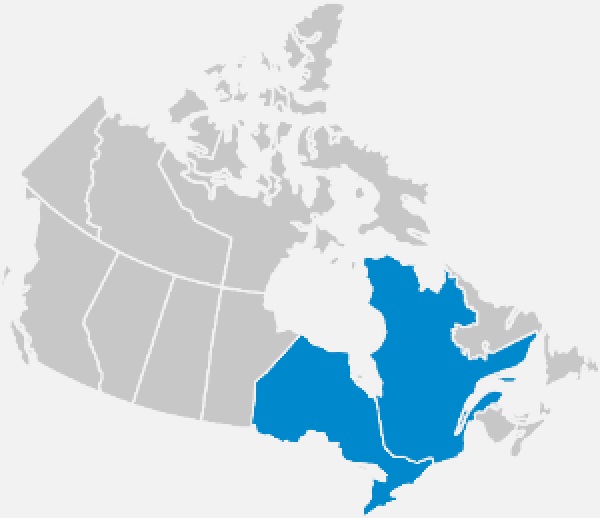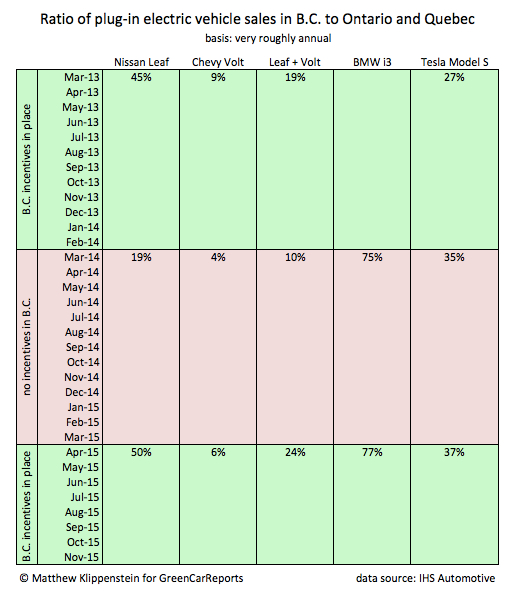![2012 Nissan Leaf in the autumn outside Ottawa, Ontario, Canada [photo: Ricardo Borba] 2012 Nissan Leaf in the autumn outside Ottawa, Ontario, Canada [photo: Ricardo Borba]](https://images.hgmsites.net/lrg/2012-nissan-leaf-in-the-autumn-outside-ottawa-ontario-canada-photo-ricardo-borba_100445702_l.jpg)
2012 Nissan Leaf in the autumn outside Ottawa, Ontario, Canada [photo: Ricardo Borba]
In the past two months, the Canadian provinces of Ontario and Quebec announced aggressive climate-change policies, both featuring strong plug-in electric vehicle support.
Ontario's provincial government followed up on its recently-strengthened purchase rebates with a battery of policies including four years of free overnight charging for electric car owners.
For its part, the province of Quebec followed through on its long-standing promise to introduce a Zero Emissions Vehicle mandate.

Provinces of Ontario and Quebec, Canada
Ontario's highlight reel
The Ontario government's 86-page (but highly readable) climate change action plan booklet hits all the notes long since sought by environmentally-minded political progressives.
A cap-and-trade carbon pricing system is expected to provide the bulk of funds for the initiatives, which include fuel shifting, a "green bank" to help finance retrofits, and support for lower income households.
Transportation is discussed on pages 18-23, and policies pertaining to plug-in electric vehicles include:
- A target for plug-in electric and hydrogen vehicles to represent 5 percent of new car sales by 2020. (About 14,000 out of roughly 285,000.)
- Continuation of rebates for electric vehicle purchases (up to $14,000) and home charging stations (up to $1,000) through 2020.
- Exempting plug-ins from the 8 percent provincial sales tax, within two years.
- The aforementioned free nighttime charging initiative. Presumably, meters will be placed on home chargers' circuits, with the government rebating those costs to utilities.
- Encouraging the build-out of high-speed chargers at highway rest stops.
- Requiring all newly-built commercial office buildings and workplaces to provide charging infrastructure.
- Requiring all newly-built Ontario homes and townhomes with garages to have a 50 amp, 240 volt (12 kW) receptacle.
The sales tax exemption might have the greatest near-term impact, as it could reduce the purchase price of a new plug-in electric vehicle by a further $3,000. (It might also suppress sales in late 2017, as buyers wait for the exemption to kick in, in 2018.)
In the long term, wiring the garages of all new detached housing with 12 kW electric outlets might have the biggest impact. To adapt a quote from a relatively famous American movie based on a relatively obscure Canadian novel, "if you build it, the electric vehicles will come"!

Strategy for electrifying transportation, Province of Quebec, Oct 2013
...and Quebec's
Quebec's Zero Emissions Vehicle mandate is the latest phase of its Transportation Electrification Action Plan, which includes 35 electric car-relevant initiatives.
They are described in a four-page brochure (which so far we have only been able to find in French).
That plan includes the following targets:
- 100,000 plug-in electric vehicles on Quebec's roads by 2020 (a big jump from the 10,000 currently in the province)
- 2015 saw about 2,900 new plug-ins sold in the province, or 0.7 percent market share
- 2018's target is 14,500 plug-ins, representing 3.4 percent
- 2020's target is 30,000 plug-ins, representing 6.9 percent
- 2025's target is 70,000 plug-ins, representing 15.5 percent
These are lofty and commendable goals, though of course it's much easier to announce targets than to meet them. While automakers have already pushed back, the ZEV approach was strongly endorsed by Mark Jaccard, a prominent Canadian academic.

Effect of electric-car purchase incentives on Tesla Model S sales in B.C. vs Ontario and Quebec
Writing in Policy Options, Jaccard noted that while carbon pricing is the most efficient mechanism for reducing societal greenhouse gas emissions, it simply isn't politically viable in most jurisdictions for legislators to raise carbon prices to the level where consumer behaviour materially changes.
Ontario from 15,240 meters (50,000 feet)
Ontario and Quebec share about two-thirds of the country's population between them (about 22 of Canada's 36 million people), and represent about three-quarters of Canada's plug-in electric vehicle market.
Their recently-reinforced support bodes well for the electric car market. Among other things, its maker has strongly hinted that the Volkswagen eGolf, not currently sold in Canada, will soon be made available to the country's car buyers.
![2012 Nissan Leaf in the autumn outside Ottawa, Ontario, Canada [photo: Ricardo Borba] 2012 Nissan Leaf in the autumn outside Ottawa, Ontario, Canada [photo: Ricardo Borba]](https://images.hgmsites.net/lrg/2012-nissan-leaf-in-the-autumn-outside-ottawa-ontario-canada-photo-ricardo-borba_100445702_l.jpg)
2012 Nissan Leaf in the autumn outside Ottawa, Ontario, Canada [photo: Ricardo Borba]
Ontario, the more westerly of the two provinces, eliminated its use of coal in 2014, and about 80 percent of its electricity is nuclear or hydroelectric. (Natural gas provides the bulk of the balance.)
With its nuclear power plants running 24/7, the province produces more electricity than it consumes at night, and its utilities have to find buyers at very low wholesale rates. Using plug-ins to increase Ontario's noctural electric demand could help the utilities in the long term, as well.
Ontario is also home to several auto assembly plants. Toyota has two, with its Cambridge facility having the distinction of being the company's first non-Japanese factory to be allowed to manufacture Lexus vehicles.

Ratio of Canadian plug-in electric vehicle sales in British Columbia to those in Ontario and Quebec
The presence of Lexus may explain the inclusion of hydrogen fuel cell technology in the government's policy materials. And the collective political clout of the auto sector probably explains why Ontario didn't include a Zero Emission Vehicle mandate.
Quebec de 15,240 metres (50,000 pieds)
With its electric grid powered almost entirely by hydroelectricity and an insignificant fossil-fuel sector, Quebec's receptiveness to electric vehicles is understandable. The province—Canada's largest—has lithium deposits, and was recently ranked the fourth-friendliest jurisdiction for mining in North America.
Quebec has committed to exploring the electrification of freight and public transport, and to electrifying its own fleet, making the province's school buses a potentially early market segment.
Though it lacks an automotive sector, the province is home to Volvo Buses subsidiary Nova Bus, which might translate to stronger-than-average policy support for bus electrification.
The province is also trying to make itself a hub for relevant international scientific and technical events in Quebec, including the 29th annual Electric Vehicle Symposium, held in Montreal over a four-day period that ended yesterday.
_______________________________________












